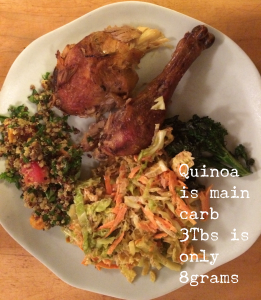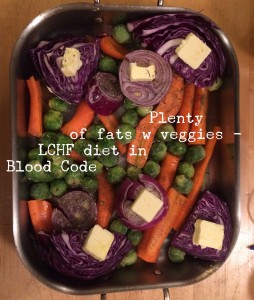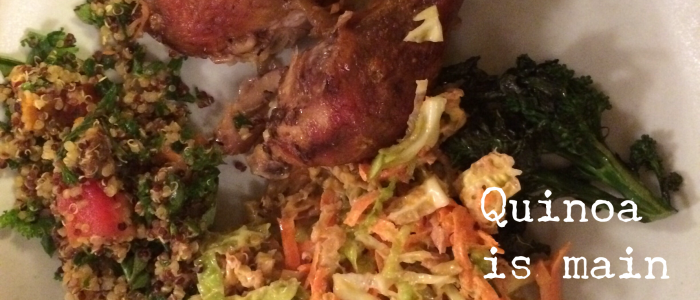This post is from the Meal Planner in The Blood Code book.
For those of you (us) who eat a quicker, more incidental lunch, the evening meal becomes even more important, since it might comprise nearly half of your calories for the day. People who have successfully corrected their Blood Code often share the same dinner/meal secret. Are you ready for this? You can have more than one vegetable with dinner.
It’s simple: Your old, meat, vegetable, and potato/bread/pasta meal can be modified to meat, vegetable, vegetable, vegetable.
Dinner #1: “I didn’t prepare and don’t have time.”
For this meal, find a protein that you can cook quickly (preprepared vegetables are helpful).
Meats: Beef tips or hamburger (get the highest fat content possible) are ready in a pan in only 10 minutes. Chicken typically takes longer, but this might be a time to go for a boneless skin-on chicken thigh for the pan.
Thin filets of fish: Cover with butter, herbs, and lemon slices and bake or broil until it flakes (usually in only 5 minutes). Salad: This can be as simple as the lettuce of your choice, or with added vegetables. Use the dressing listed at the end of this chapter.
Steamed vegetables: Broccoli and/or carrots cut lengthwise, or asparagus, or any other vegetable that brightens and softens when steamed. Done within 5 minutes; add olive oil or butter.
Sautéed vegetables: If you have cooked steak tips or hamburger, you will have the drippings in the pan. Add butter or olive oil to the drippings and quick-sauté any “tougher” vegetable, like string beans, mushrooms, fennel, onions, garlic, snow peas, or the dark leafy greens (collards/chard/kale). You won’t be baking a squash for this meal, because you’re in a hurry, remember?
Dinner #2: “I have time earlier in the day to prepare.”
Meat/fish/chicken: Buy any bone-in cut you can find. Recover the fats and nutrient-rich juices that cook out.
Bone-in pork roast / bone-in beef roast / bone-in lamb roast: Sear the outside with a heat-tolerant fat, like lard or ghee. Olive oil will also work here. This is messy without a screen cover; get it to snap-crackle-pop. Once all sides are browned—this will take a total of 10 minutes—place in a covered oven-roasting pot. (I do my browning and slow-cooking in the same Creuset pan—less to clean.) Set the oven at about 250 degrees Fahrenheit and roast for four to six hours. This cooking method is called a “braise,” and Crock-Pots are designed for this purpose. The minerals and nutrients inside the bone cook into the meat and juices.
Whole chicken can be done in a similar fashion, without the browning, and the bird will only need about four hours. Make sure it is covered well, in a Creuset, clay pot, or in a pan with foil. Uncover at the end if you want it browned a little.
Fish: Look for a whole fish; this takes some time to take apart once cooked, but remember, this is a meal for when you have time.
 Roasted root vegetables: About 30 to 60 minutes before the meal, put root vegetables (onions, carrots, potatoes, parsnips, or pieces of turnip and winter squash) in the pot with the roast; they will cook in the nutritious juices. Remember that the carrots and turnips have less than a third the carb content as potatoes for the same volume, so choose the lower-carb root veggies listed in Step Four, Dietary Carbohydrates (see page 118).
Roasted root vegetables: About 30 to 60 minutes before the meal, put root vegetables (onions, carrots, potatoes, parsnips, or pieces of turnip and winter squash) in the pot with the roast; they will cook in the nutritious juices. Remember that the carrots and turnips have less than a third the carb content as potatoes for the same volume, so choose the lower-carb root veggies listed in Step Four, Dietary Carbohydrates (see page 118).
Just before the meal, put together a salad. Lay out a plate of raw veggies as a side dish—like radishes, snap peas, or cucumber—to balance out the warming, hearty flavors of the slow-cooked braise.
Again, we have the same theme: meat, veggie, veggie, veggie. And remember, make too much; the main course will provide leftovers for an excellent lunch in upcoming days.
Dinner #3: “I’m eating out.”
The rules of eating out for dinner are the same as they are for lunch. Eliminate the pre-meal bread; this will prevent your insulin from going up even before the meal arrives. Dinner does offer an extra challenge over lunch: alcohol. This was discussed in the earlier “Lifestyle Habits” chapter, and should be respected for both the carb content of the alcoholic beverage, and the fat storage effect that the alcohol triggers.
Most every restaurant, even though the option may not be listed on the menu, will offer an extra serving of vegetables instead of pasta/potato/rice. Even the barbecue restaurants in New England offer side dishes of stewed collards and pickled okra. I can always find a balanced meal trading in the corn bread for some coleslaw and greens. Enjoy.
Your personal cuisine should play a significant role in how you apply the principles of The Blood Code Diet; therefore, your dietary success will look very different from that of a person from a different culture or cuisine. The conversation needs to be ongoing.




Comments are closed.